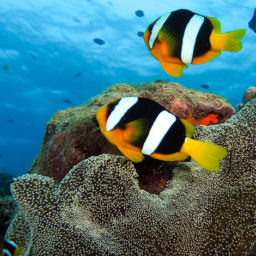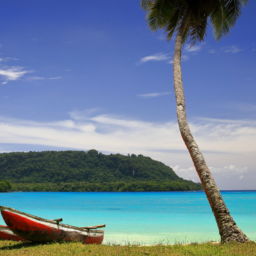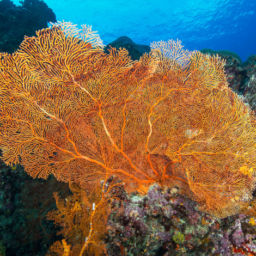Tell any scuba diver that you’re planning a trip to Vanuatu and they’ll ask if you’re going to dive the SS President Coolidge, one of the most famous wreck dives in the world. Scuttled accidentally toward the end of WWII, the enormous ship is over 590 feet (180 m) long and divers have been exploring it since the 1980s. But the Coolidge isn’t the only great wreck dive in Vanuatu. Here are our picks for five fantastic Vanuatu wreck dives.
The SS President Coolidge
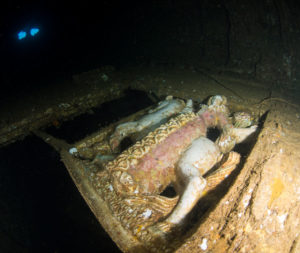
The Coolidge, of course, has to take top billing. And not just for its sheer size, but also for its easy access and all the amazing artifacts and creatures you’ll find in its hidden depths. Three dive operators in Santo have well-organized shore-dive access to the Coolidge. From shore, it’s a short walk across the beach before you descend and follow a line down to the bow.
One of the first creatures you’ll meet is Nessie, an enormous long-time resident moray eel who lives in the anchor hole before you descend deeper to explore the cargo holds. Inside you’ll find jeeps, ammunition, a barber’s chair, a row of toilets and, in the deeper and darker cavities, flashlight fish and electric clams.
Deeper still, it’s traditional for divers to enter the old ballroom to find ‘The Lady’ (an old bas-relief of an Elizabethan lady on a horse), and give her a kiss, before descending even deeper to the stern at 229 feet (70 m) for the ultimate bragging-rights photo next the ship’s name.
On the way back up, you’ll find old guns, Coke bottles, gas masks and tea cups for a few more photo opportunities before heading for the deco stop – a beautiful garden of anemones.
The Bonzer Wreck, Hideaway Island, Efate
The Bonzer Wreck is a great wreck dive for first-timers. Sitting at a depth of 79 feet (24 m), the top is only 39 feet (12 m) deep, thusly it’s very accessible for beginner divers. It sits in clear, warm tropical water, surrounded by a pretty coral reef, only a 5-minute boat ride from Hideaway Island Resort.
The dive starts at the edge of a shallow reef and continues through a gully covered in corals of all shapes and colors. On top of a nearby large coral bommie there is an enormous bed of anemones, which is great fun to spend some time watching before heading to the wreck itself, an old tug boat.
The Bonzer is covered in coral, with soft corals feathering the windows of the bridge (which you can swim through) as well as the railings and superstructure on the upper deck. Peek inside to see swarms of glassfish and cleaner shrimp hiding in the corners.
The USS Tucker, Espiritu Santo
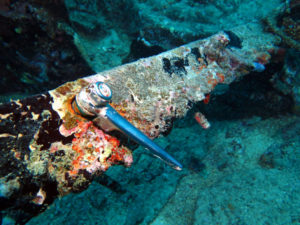
The USS Tucker, another WWII casualty, hit a (friendly) mine that split the ship in two. The wreck is a 30-minute boat ride from Luganville jetty at about 82 feet (25 m) deep. It sits on a white, sandy bottom in clear water, close to the mouth of the channel between Aore Island and the main island of Espiritu Santo.
Schools of snapper and jacks circle the exterior, and under the wreckage you’ll find huge gatherings of tiny glassfish in the smaller cavities. Batfish, angelfish and coral trout populate the larger overhangs.
Purple soft corals cling to parts of the engine, winches and superstructure, while sea fans brighten up the darker parts of the deck and hull.
The Semele Federesen, Port Vila, Efate
A 10-minute boat ride from the Nambawan Café on the Port Vila waterfront, this old inter-island cargo vessel was scuttled in 1985. It sank to the bottom of Port Vila Bay at a depth of 124 to 180 feet (38 to 55 m), with the top of the wreck at 98 feet (30 m).
While it’s not for beginners, it’s an easy dive with no current, in crystal-clear and incredibly blue water. You can see the wreck below you from just below the surface as you descend slowly toward it, a silhouette against a rich blue background. As you get closer, you’ll see the exterior is decorated with fans and soft corals of all the colors of the rainbow.
Swim down to the stern and propeller to see the largest sea fans before ascending to shallower depths to explore the very pretty adjacent coral reef.
Million Dollar Beach, Espiritu Santo
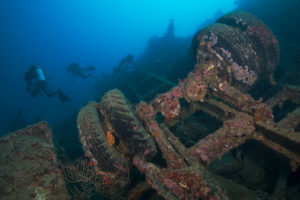
At the end of World War II, the U.S. forces had a dilemma. They had shipped millions of dollars’ worth of equipment here over the course of the Pacific war with no easy way to get it back home again, and where they didn’t really need it anyway. Nobody wanted to (or had the money to) buy it and they didn’t want to just give it away.
So, they scuttled it. Literally tipped it over the end of the jetty on what is now called Million Dollar Beach. Jeeps, tractors, cranes and various other large pieces of infrastructure now litter the steep slope from the shoreline into the lagoon.
Schools of juvenile fish have found a home here and the nooks and crannies are a macro-lover’s dream with colorful nudibranchs and feather stars. But the spoils of war truly make this dive site intriguing.
Millions of dollars’ worth of equipment now encrusted with colorful corals — a playground for divers.






